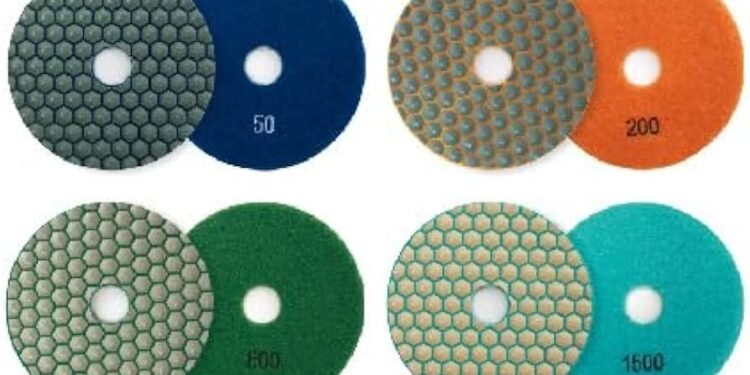Trying to figure out whether dry polishing pads or wet polishing pads are best for your project? It can be confusing, but picking the right one makes a big difference in how your work turns out. Whether you’re polishing stone, concrete, or another material, each pad type has its benefits. In this blog, we’ll break down the differences between dry and wet polishing pads to help you make the best choice.
What Are Dry Polishing Pads?
Dry polishing pads are designed to polish stone surfaces without water. They are typically used when water supply is limited, or it’s not practical to use water.
- Convenience: These pads are convenient because you don’t need to worry about water supply or mess.
- Portability: Ideal for jobs in remote areas or places without easy access to water.
- Versatility: Can be used on various stone surfaces, including granite, marble, and concrete.
What Are Wet Polishing Pads?
Conversely, wet polishing pads require water to cool the pad and the stone surface during the polishing process.
- Cooling Effect: The water helps to cool down the pads and the stone, preventing overheating.
- Dust Control: Wet polishing reduces the dust created, making it cleaner.
- Finish Quality: Often provides a smoother, more refined finish on the stone surface.
Comparing Dry and Wet Polishing Pads
Let’s look at the main differences between dry and wet polishing pads.
1. Convenience and Portability
- Dry Polishing Pads: These pads are very portable. You can use them anywhere because you don’t need a water source. This makes them perfect for small jobs or where getting water is hard.
- Wet Polishing Pads: These pads need water, so they are less portable. But they are better for big projects where you need a nice finish. Setting up might take longer, but it’s worth it for bigger jobs.
2. Dust and Mess
- Dry Polishing Pads: These pads can create a lot of dust. This is a problem if you’re working indoors or in places where you need to keep things clean. You might need a vacuum or something to control the dust.
- Wet Polishing Pads: The water used with these pads helps keep the dust down, making the process cleaner and less messy. This is great for indoor work or places where dust is a problem.
3. Finish Quality
- Dry Polishing Pads: These pads can give a good finish, but they might not be as smooth or shiny as wet polishing. They are good for quick jobs but not the best for perfect finishes.
- Wet Polishing Pads: These pads usually give a higher-quality, smoother finish. The water helps reduce friction, making the surface more polished. They are the best choice when you need a top-notch finish.
4. Tool Wear and Tear
- Dry Polishing Pads: Without water, there is more friction and heat. This can wear out the pads and tools faster, meaning you might have to replace them more often.
- Wet Polishing Pads: The water helps cool down the pads and tools, which reduces wear and tear. This means your tools last longer, saving you money over time.
When to Use Dry Polishing Pads
Dry Polishing Pads are best suited for:
- Small Projects: Ideal for quick touch-ups or small polishing tasks.
- Remote Locations: Perfect for areas where water is not available.
- Indoor Use: Good indoor use if dust control methods are in place.
When to Use Wet Polishing Pads
Wet polishing pads are better for:
- Large Projects: Best for extensive polishing tasks where a high-quality finish is essential.
- Dust-Sensitive Areas: Ideal for environments where dust control is important.
- Professional Use: Preferred by professionals looking for the best possible finish.
Tips for Using Dry Polishing Pads
If you decide to use Dry Polishing Pads, here are some tips to get the best results:
- Use a Dust Collection System: This helps manage the dust created during polishing.
- Wear Protective Gear: Use masks and eye protection to protect from dust and debris.
- Take Breaks: Allow the pads and tools to cool down between uses to prevent overheating.
Tips for Using Wet Polishing Pads
For those opting for wet polishing pads, consider these tips:
- Ensure Proper Water Flow: A consistent water flow keeps the pads and stone cool.
- Protect the Area: Use tarps or plastic sheets to protect the surrounding area from water and slurry.
- Check the Finish Regularly: Keep checking the stone to ensure you achieve the desired level of polish.
Conclusion
Choosing between dry polishing pads and wet polishing pads depends on your specific needs and project requirements. If convenience and portability are your priorities, dry polishing pads are a great choice. However, wet polishing pads might be better for you if you are looking for a higher-quality finish and dust control. For top-quality dry polishing pads, visit Tait Sales & Consulting. They offer a wide range of polishing tools to suit all your needs. Invest in the right tools and achieve the best results for your stone polishing projects!






